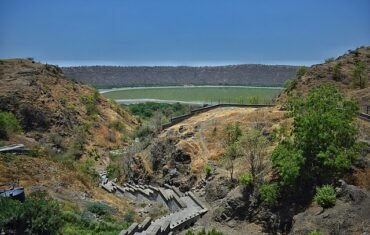Overview
Mawjymbuin Caves, located in the East Khasi Hills of Meghalaya, India, is a popular natural attraction that draws visitors with its unique geological formations and spiritual significance. The cave is known for its stalagmite formations, with one particularly famous formation resembling a Shiva Linga, which holds religious importance for Hindu devotees. The name “Mawjymbuin” is derived from the Khasi language, with “Maw” meaning stone and “Jymbuin” referring to a shape that resembles a hollow. Gangtok One Day Local Sightseeing By Private Cab.
Mawjymbuin Caves are more than just a tourist destination; they are a marvel of natural architecture shaped over thousands of years. The intricate limestone formations, along with the moist, cool atmosphere inside the cave, create an otherworldly experience. The caves are surrounded by lush green hills and rich biodiversity, adding to the allure of the location. Nathula Pass: Famous Gateway to Indo-China Relations and Himalayan Grandeur
Location of Mawjymbuin Caves

- State: Meghalaya, India
- District: West Khasi Hills
- Village: Mawsynram
- Coordinates: Approximately 25.2986° N, 91.5822° E
The Mawjymbuin Caves are located near the village of Mawsynram, known to be one of the wettest places on Earth. Situated about 60 kilometers from Shillong, the state capital of Meghalaya, the caves are easily accessible for tourists looking to explore the natural wonders of the region.
Time/Entry Fees of Mawjymbuin Caves

Visiting Hours
Mawjymbuin Caves are open to visitors throughout the year, but the best time to visit is during the dry season when the cave interiors are less slippery.
- Opening Hours: 9:00 AM to 5:00 PM daily
Entry Fees
- Adults: INR 10 per person
- Children: INR 5 per person
The entry fee is nominal, making it an affordable attraction for all visitors. The funds collected from the entry fees are used for the maintenance and conservation of the caves.
How to Reach Mawjymbuin Caves

By Air
The nearest major airport to Mawjymbuin Caves is the Shillong Airport, also known as Umroi Airport, which has limited connectivity. For better accessibility, most travelers opt to fly into Lokpriya Gopinath Bordoloi International Airport in Guwahati, Assam.
- Nearest Major Airport: Lokpriya Gopinath Bordoloi International Airport, Guwahati, Assam
- Distance from Guwahati to Mawsynram: Approximately 170 kilometers
- Travel Time: Around 5 to 6 hours by road
From the airport, visitors can hire a taxi or take a shared vehicle to reach Shillong and then proceed to Mawsynram.
By Rail
Shillong does not have a railway station. The nearest railhead is in Guwahati, Assam.
- Nearest Railway Station: Guwahati Railway Station (GHY)
- Distance from Guwahati to Mawsynram: Approximately 150 kilometers
- Travel Time: Around 5 hours by road
From Guwahati, tourists can take a taxi, shared cab, or bus to Shillong. From Shillong, local transport options are available to reach Mawsynram.
By Road
Mawjymbuin Caves are well connected by road. The journey from Shillong to Mawsynram offers scenic views of rolling hills and lush greenery.
- Distance from Shillong to Mawjymbuin Caves: Approximately 58 kilometers
- Travel Time: Around 2 hours
Regular buses and shared cabs operate between Shillong and Mawsynram. Visitors can also hire private taxis for a more comfortable journey.
Things to Do at Mawjymbuin Caves

1. Explore the Cave’s Geological Wonders
The Mawjymbuin Caves are known for their impressive stalagmite and stalactite formations. Exploring the cave’s interiors allows visitors to witness these natural formations up close. The highlight of the cave is the stalagmite shaped like a Shiva Linga, which attracts devotees and tourists alike.
2. Photography
The Mawjymbuin Caves offer unique photographic opportunities with their natural rock formations and the play of light and shadow inside the cave. Photography enthusiasts can capture the mystical beauty of the cave’s interiors and the surrounding landscape.
3. Experience the Spiritual Ambiance
The Shiva Linga inside Mawjymbuin Caves adds a spiritual dimension to the visit. The cave is considered a sacred place by many Hindu devotees who come to offer prayers. The peaceful and serene ambiance of the cave makes it an ideal spot for meditation and introspection.
4. Enjoy the Surrounding Natural Beauty
The area around Mawjymbuin Caves is rich in natural beauty, with lush green hills, dense forests, and streams. Visitors can enjoy a leisurely walk in the surrounding areas, breathe in the fresh air, and immerse themselves in the tranquility of nature.
5. Visit the Local Market
Mawsynram village offers a glimpse into the local culture and lifestyle. Visitors can explore the local market, where traditional Khasi items, handmade crafts, and local produce are sold. This is a great opportunity to interact with the local community and understand their way of life.
Nearest Tourist Attractions of Mawjymbuin Caves
Umiam Lake: A Serene Oasis in the Heart of Meghalaya
Overview Umiam Lake, also known as Barapani Lake, is a picturesque reservoir located in the…
Mawjymbuin Caves: Best Journey into Meghalaya’s Natural Wonder
Overview Mawjymbuin Caves, located in the East Khasi Hills of Meghalaya, India, is a popular…
Elephant Falls Shillong: Best Natural Wonder in the Abode of Clouds
Overview Elephant Falls is one of the most popular and scenic waterfalls in Shillong, Meghalaya….
Ward’s Lake Shillong: A Serene Escape in the Heart of Meghalaya
Overview Ward’s Lake, also known as Nan-Polok by locals, is a picturesque artificial lake nestled…
Laitlum Church: A Tranquil Retreat Amidst Meghalaya’s Scenic Beauty
Overview Laitlum Church, located in the heart of the Laitlum Canyons in Meghalaya, India, is…
1. Mawsynram Village
Known for its record-breaking rainfall, Mawsynram is a charming village that offers stunning views of the surrounding hills and valleys. It is an ideal place to experience the local culture and enjoy the scenic beauty of Meghalaya.
2. Mawsmai Cave
Located about 60 kilometers from Mawjymbuin Caves, Mawsmai Cave is another popular cave attraction in Meghalaya. This limestone cave is known for its intricate formations and narrow passageways, making it a favorite spot for adventure seekers.
3. Nohkalikai Falls
Approximately 90 kilometers from Mawjymbuin Caves, Nohkalikai Falls is one of the tallest waterfalls in India, with a sheer drop of over 300 meters. The breathtaking waterfall is set amidst lush green hills and offers panoramic views.
4. Cherrapunji
About 70 kilometers from Mawjymbuin Caves, Cherrapunji is famous for its heavy rainfall, living root bridges, and natural attractions. It is a must-visit destination for nature lovers and adventure enthusiasts.
5. Shillong
The capital city of Meghalaya, Shillong, is approximately 60 kilometers from Mawjymbuin Caves. Shillong offers a range of attractions, including Ward’s Lake, Elephant Falls, and Don Bosco Museum, making it a perfect base for exploring the region.
Significance/History of Mawjymbuin Caves
Mawjymbuin Caves hold both geological and religious significance. The cave’s limestone formations have been shaped over thousands of years, creating a natural wonder that attracts geologists and tourists alike. The presence of the Shiva Linga inside the cave adds religious importance, making it a pilgrimage site for Hindu devotees.
The cave’s unique structure, with its stalagmites and stalactites, provides valuable insights into the geological history of the region. Mawjymbuin Caves are part of Meghalaya’s rich cave system, which is one of the largest and most diverse in the Indian subcontinent.
For the local Khasi community, Mawjymbuin Caves hold cultural significance, representing a natural treasure that has been passed down through generations. The caves are also a reminder of the region’s deep connection to nature and the spiritual beliefs that are intertwined with the land.
FAQs
Q1: Is Mawjymbuin Caves safe for all visitors?
A1: Mawjymbuin Caves are generally safe for visitors, but care should be taken while exploring the cave’s interiors, as the floors can be slippery. It is advisable to wear sturdy footwear with good grip and to carry a flashlight for better visibility.
Q2: What is the best time to visit Mawjymbuin Caves?
A2: The best time to visit Mawjymbuin Caves is during the dry season, from October to April, when the weather is pleasant and the cave interiors are less slippery. Monsoon season should be avoided due to heavy rainfall, which can make the area around the cave more challenging to navigate.
Q3: Are guided tours available at Mawjymbuin Caves?
A3: While there are no official guided tours, local guides are available who can provide insights into the cave’s history, significance, and geological features. Hiring a local guide can enhance the experience of exploring the caves.
Q4: Can I take photographs inside the Mawjymbuin Caves?
A4: Yes, photography is allowed inside Mawjymbuin Caves. However, it is recommended to avoid using flash photography near the Shiva Linga out of respect for the religious sentiments of visitors.
Q5: How much time should I allocate for visiting Mawjymbuin Caves?
A5: A visit to Mawjymbuin Caves typically takes about 1 to 2 hours, depending on how much time you spend exploring the cave’s interiors and the surrounding areas. It is advisable to take your time to fully appreciate the natural formations and the spiritual ambiance.
Conclusion
Mawjymbuin Caves, with their unique geological formations and spiritual significance, offer a captivating experience for visitors. Located near Mawsynram, one of the wettest places on Earth, the caves are a testament to the natural beauty and cultural heritage of Meghalaya. Whether you are a nature lover, a spiritual seeker, or an adventure enthusiast, Mawjymbuin Caves provide a memorable journey into the heart of















Comments are closed.